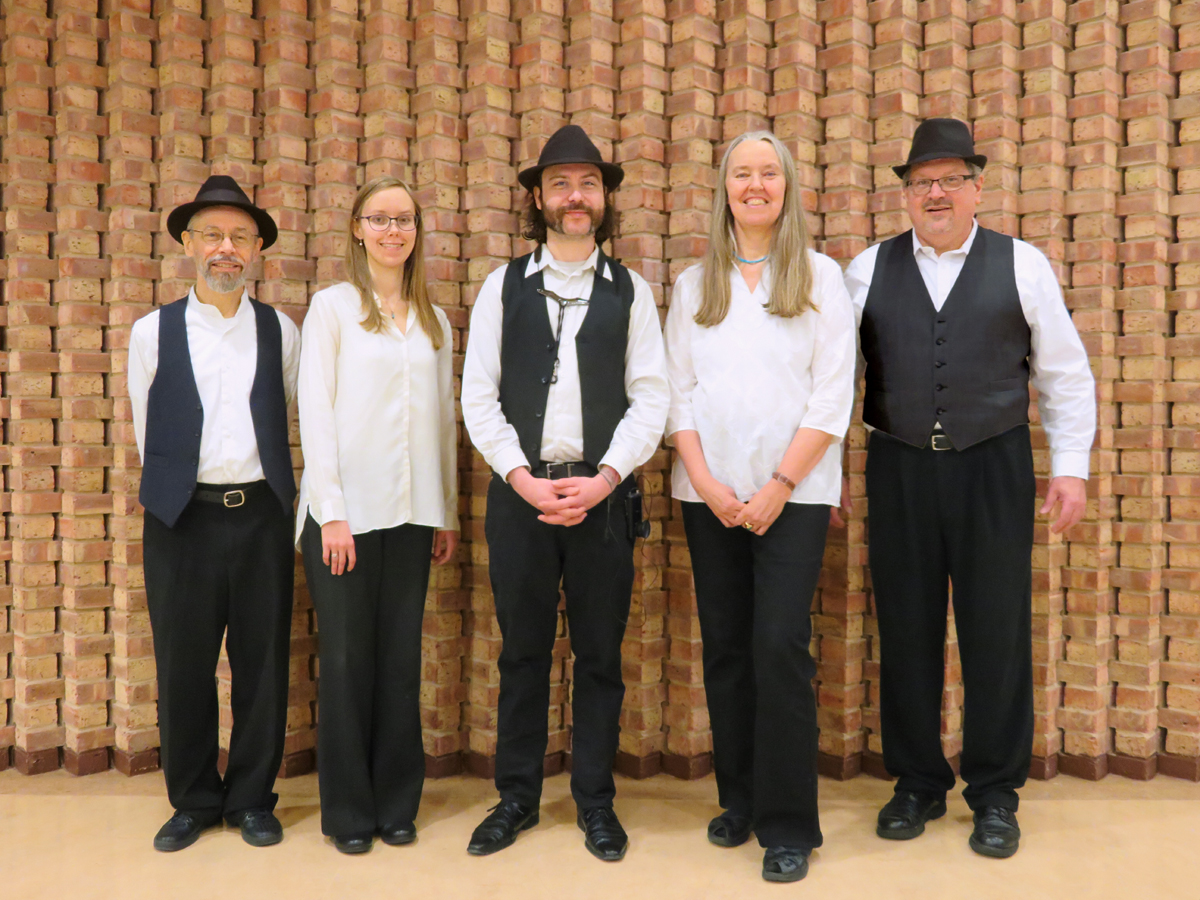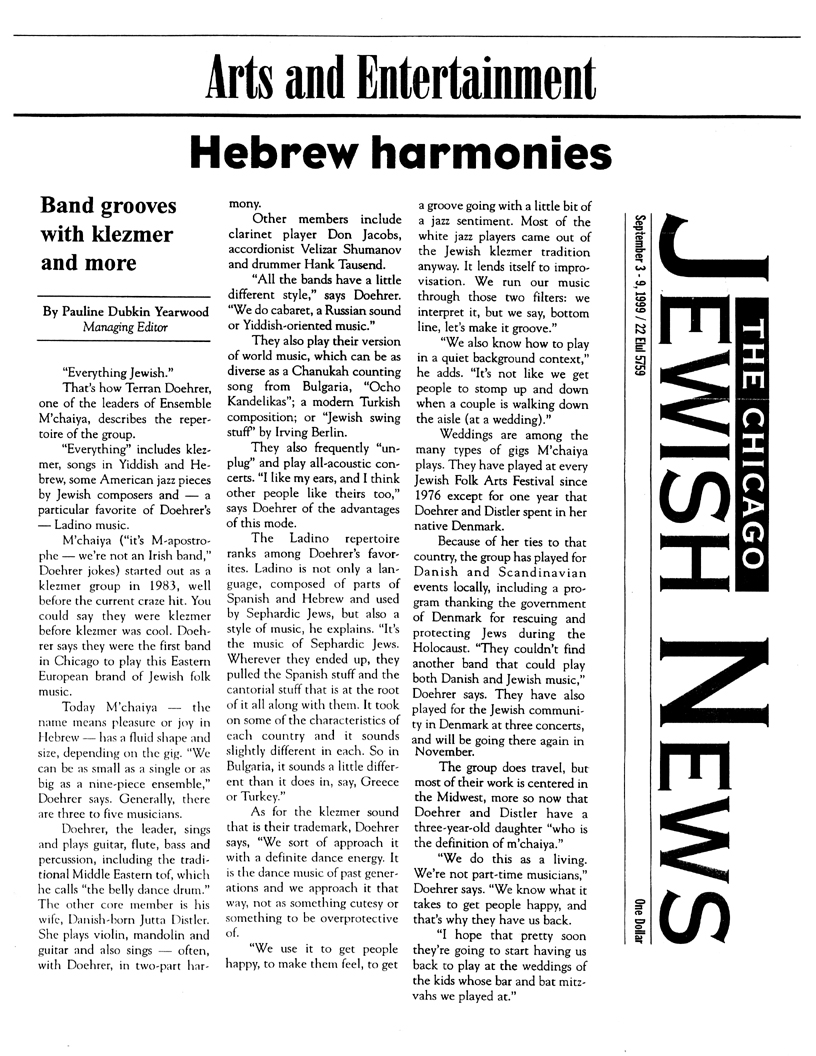ENSEMBLE
M’CHAIYA

Hebrew harmonies
Band grooves with klezmer and more
The Chicago Jewish News — Arts & Entertainment — By Pauline Yearwood, Managing Editor, September 3, 1999.

“Everything Jewish.”
That’s how Terran Doehrer, one of the leaders of Ensemble M’chaiya (tm) describes the repertoire of the group.
“Everything” includes klezmer, songs in Yiddish and Hebrew, some American jazz pieces by Jewish composers and — a particular favorite of Doehrer’s — Ladino music.
M’chaiya (“it’s M-apostrophe — we’re not an Irish band,” Doehrer jokes) started out as a klezmer group in 1983, well before the current craze hit. You could say they were klezmer before klezmer was cool. Doehrer says they were the first band in Chicago to play this Eastern European brand of Jewish folk music.
Today M’chaiya — the name means pleasure or joy in Hebrew — has a fluid shape and size, depending on the gig. “We can be as small as a single or as big as a nine-piece ensemble,” Doehrer says. Generally, there are three to five musicians.
Doehrer, the leader, sings and plays guitar, flute, bass, and percussion, including the traditional Middle Eastern tof, which he calls “the belly dance drum.” The other core member is his wife, Danish-born Jutta Distler. She plays violin, mandolin, and guitar and also sings — often, with Doehrer, in two-part harmony.
Other members include clarinet player Don Jacobs, accordionist Velizar Shumanov, and drummer Hank Tausend.
“All the bands have a little different style,” says Doehrer. “We do [Gypsy and Sephardic styled] music.“ {Editor’s note: bracketed material corrects material errors in the article.}
They also play their version of world music, which can be as diverse as a Chanukah counting song from Bulgaria, “Ocho Kandelikas”; a modern Turkish composition; or “Jewish swing stuff” by Irving Berlin.
They also frequently “unplug” and play all-acoustic concerts. “I like my ears, and I think other people like theirs too,” says Doehrer of the advantages of this mode.
The Ladino repertoire ranks among Doehrer’s favorites. Ladino is not only a language, composed of part of Spanish and Hebrew and used by Sephardic Jews but also a style of music, he explains. “It’s the music of Sephardic Jews. Wherever they ended up, they pulled the Spanish stuff and the cantorial stuff that is at the root of it all along with them. It took on some of the characteristics of each country and it sounds slightly different in each. So in Bulgaria, it sounds a little different than it does in, say, Greece or Turkey.”
As for the klezmer sound that is their trademark, Doehrer says, “We sort of approach it with a definite dance energy. It is the dance music of past generations and we approach it that way, not as something cutesy or something to be overprotective of.
“We use it to get people happy, to make them feel, to get them a groove going with a little bit of a jazz sentiment. [Many] of the white jazz players came out of the Jewish klezmer tradition anyway. It lends itself to improvisation. We run our music through those two filters: we interpret it, but we say, bottom line, let’s make it groove.”
“We also know how to play in a quiet background context,” he adds. “It’s not like we get people to stomp up and down when a couple is walking down the aisle (at a wedding).”
Weddings are among the many types of gigs M’chaiya plays. They have played at every Jewish Folk Arts Festival since 1976 except for one year that Doehrer and Distler spent in her native Denmark.
Because of her ties to that country, the group has played for Danish and Scandinavian events locally, including a program thanking the government of Denmark for rescuing and protecting Jews during the Holocaust. “They couldn’t find another band that could play both Danish and Jewish music,” Doehrer says. They have also played for the Jewish community in Denmark at three concerts, and will be going there again in November.
The group does travel, but most of their work is centered in the Midwest, more so now that Doehrer and Distler have a three-year-old daughter “who is the definition of m’chaiya.”
“We do this as a living. We’re not part-time musicians,” Doehrer says. “We know what it takes to get people happy, and that’s why they have us back.
“I hope that pretty soon they’re going to start having us back to play at the weddings of the kids whose bar and bat mitzvahs we played at.”